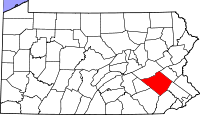Berks County
| Berks County, Pennsylvania | ||
|---|---|---|

The Reading area from the Pagoda
|
||
|
||
 Location in the U.S. state of Pennsylvania |
||
 Pennsylvania's location in the U.S. |
||
| Founded | March 11, 1752 | |
| Seat | Reading | |
| Largest city | Reading | |
| Area | ||
| • Total | 866 sq mi (2,243 km2) | |
| • Land | 857 sq mi (2,220 km2) | |
| • Water | 9.2 sq mi (24 km2), 1.1% | |
| Population (est.) | ||
| • (2015) | 415,271 | |
| • Density | 485/sq mi (187/km²) | |
| Congressional districts | 6th, 7th, 15th, 16th | |
| Time zone | Eastern: UTC-5/-4 | |
| Website | www |
|
| Footnotes: | ||
| Designated | May 12, 1982 | |
Berks County (Pennsylvania German: Barricks Kaundi) is a county located in the U.S. state of Pennsylvania. As of the 2010 census, the population was 415,271 . The county seat is Reading.
Berks County comprises the Reading, PA Metropolitan Statistical Area (MSA), which is also included in the Philadelphia-Reading-Camden, PA-NJ-DE-MD Combined Statistical Area. (CSA).
Reading developed during the 1740s when the inhabitants of northern Lancaster County sent several petitions requesting that a separate county be established. With the help of German immigrant Conrad Weiser, the county was formed on March 11, 1752 from parts of Chester County, Lancaster County, and Philadelphia County.
It was named after the English county in which William Penn's family home lay - Berkshire, which is often abbreviated to Berks. Berks County began much larger than it is today. The northwestern parts of the county went to the founding of Northumberland County in 1772 and Schuylkill County in 1811, when it reached its current size. In 2005, Berks County was added to the Delaware Valley Planning Area due to a fast-growing population and close proximity to the other communities.
...
Wikipedia

